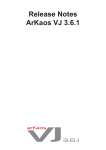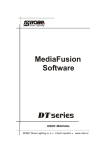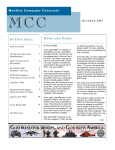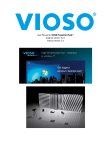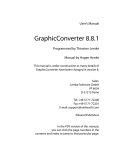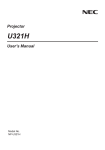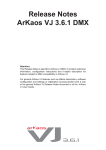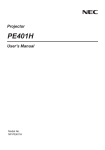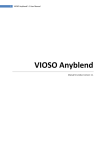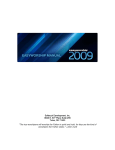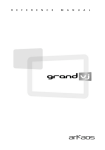Download ArKaos VJ 3.6.1 Release Notes
Transcript
Release Notes ArKaos VJ 3.6.1 Table Of Contents Introduction and registration 1 1. About this document 1 2. Two different ArKaos VJ versions: MIDI and DMX 1 3. About your license 1 4. Obtaining your serial number from the ArKaos web site 4.1. Preparing your Machine ID code 4.2. Generating your final serial number 4.2.1. If you have purchased the software from www.arkaos.net 4.2.2. If you have not purchased the software from www.arkaos.net 1 1 2 2 3 5. Using your final serial number in the software 3 6. Getting support for registration 3 ArKaos VJ 3.6.1 4 1. What’s new in ArKaos VJ 4 2. HW Mode: Hardware Acceleration in ArKaos VJ 2.1. New video engine 2.2. Advantages 2.3. Supported graphic cards 2.4. Standard Mode or HW Mode? 2.5. Effects compatibility with HW Mode 2.5.1. HW effects and Shader effects 2.5.2. Standard effects and FreeFrame effects 2.5.3. HW-incompatible effects 2.5.4. Opening in HW Mode a Synth made in Standard Mode 2.5.5. Is it better to use Standard effects or HW effects? 4 4 4 4 5 5 5 5 6 6 6 3. Core Image (Mac OS X Tiger / HW Mode only) 3.1. What is Core Image? 3.2. How to use Core Image effects in ArKaos VJ? 6 6 6 4. Shader effects (HW Mode only) 4.1. What are Shader effects? 4.2. Setting up the parameters 4.3. Shader Effects description 4.3.1. In category 3D 4.3.2. In category Video 4.3.3. In category Transitions 4.3.4. In category Artistic 4.4. Other HW Effects description 8 8 8 9 9 12 14 16 18 5. Standard Mode only effects description 22 6. FreeFrame effects (HW Mode & Standard Mode) 24 6.1. What is FreeFrame? 6.2. Managing your FreeFrame effects 6.3. How to use FreeFrame effects in ArKaos VJ? 6.4. Setting up the effect parameters 24 24 24 25 7. Position & Size settings with effects 25 8. Movie Loop control 8.1. Features explanation 8.1.1. Movie Speed 8.1.2. Movie Loop 8.2. Controller resolution 25 26 26 26 26 9. Remote Patch selection 26 10. Automation & beat detection options 10.1. Tempo / BPM options 10.2. Intelligent Automation mode 27 27 27 11. Automatic Screen Fade option 28 12. DV Output through FireWire 12.1. Important note about delay 29 29 13. Visuals format compatibility updates 13.1. About Adobe Flash support 13.2. Video For Windows / DirectShow support (PC only) 13.3. Important note about movie file compression 30 30 30 30 14. Widescreen & Multiscreen presentation 14.1. Introduction 14.2. Widescreen 14.3. Multiscreen 14.4. Connectivity; case studies a. Case 1: Dual head graphic card b. Case 2: Dual head graphic card + single head graphic card c. Case 3: Dual head graphic card + multi-display upgrade d. Other possible combinations 14.5. Output resolutions a. Pre-defined resolutions b. Custom resolutions 14.6. Monitors setup for widescreen or multiscreen projection 14.7. Monitors setup under Windows a. nVidia graphic cards b. ATI graphic cards 14.8. Monitors setup under Mac OS X 31 31 31 31 32 32 32 33 33 33 33 33 33 33 34 36 39 15. Soft-Edge 15.1. Introduction 15.2. Setup 15.3. Calibration 40 40 41 41 16. Overlay display (PC only) 42 17. Interface enhancements 42 18. Bug fixes 42 Support, Information and Contact 43 1. Solutions 1.1. ArKaos Users Forum 1.2. Knowledgebase articles 1.3. Trouble Ticket System 43 43 43 43 2. Distributors and resellers 43 Introduction and registration Thank you for having purchased our software! 1. About this document This document explains the changes between ArKaos VJ 3.0 MIDI which is fully detailed in the user guide (on your computer, in your ArKaos VJ installation folder) and the current ArKaos VJ 3.6.1 2. Two different ArKaos VJ versions: MIDI and DMX ArKaos VJ is available in 2 different versions (MIDI and DMX) which are included in the same software installer but are enabled or not depending on the license code you have purchased. Chapter B in this document describes all the features available in ArKaos VJ MIDI which are also common to ArKaos VJ DMX. A specific documentation about ArKaos VJ DMX with extensive information, configuration instructions and in-depth description for features which only apply to that software version is also available at the end of this document or, if you have purchased the DMX version boxed, as a second printed manual. 3. About your license Your software box comes with a Purchase Key code which you must keep in a safe place because it is the proof that you own a license and can be needed in the future to obtain upgrades. However, that Purchase Key code is not yet the final serial number that will register the software on your computer; you will need to create that serial number after you have installed the software (this is explained on the next page). If entered in the “Serial Number” text field in the software’s Serial Activation window, the Purchase Key also works as a sort of temporary Serial Number, extending the application’s trial period from 21 to 60 days. This gives give you more time to generate your final Serial Number, it’s also a good way to use your software on a temporary computer (e.g. on stage, during a tour, on a friend’s computer, on a computer that you rent, etc..) For your convenience, we have described on the next pages an easy way to get a final serial number for any computer directly from our web site. The ArKaos VJ user manual also describes the other registration procedures available. Finally, be sure to read the last chapter of this document where you will find all your options to get support if you should encounter any problem with the use or the registration of our software. 4. Obtaining your serial number from the ArKaos web site 4.1. Preparing your Machine ID code Once the latest version of the software is installed on your computer, you will need to locate your Machine ID Code: The Machine ID is an 8 capital letters code (e.g. UGTEDLTG) generated by ArKaos VJ. This code is unique and is used to generate a final serial number, which will only work in combination with your computer’s Machine ID code. When you launch the application for the first time, it will run in “Free Level” mode and you will be Introduction and Registration Page 1 presented with a “Registration” screen with 4 different options; choose the fourth one (“If you want to continue trying the software”). The software will launch in demo mode and open a default Synth file. Navigate to the “Serial Activation” window through the software’s menus EDIT, PREFERENCES, REGISTRATION Screenshot of the Serial Activation window with the Machine ID: 4.2. Generating your final serial number Once you have your Machine ID code ready, there are two different ways to get your final serial number depending on the fact that you purchased your software on our web site (www.arkaos.net) or not (i.e. in a shop, on another web site, etc..). 4.2.1. If you have purchased the software from www.arkaos.net You have registered as an ArKaos customer when you placed your order and your software license has immediately been added to your customer profile on our web site; • Prepare all the info you will need: o The e-mail and password you entered in our online shop database when you bought your software o The Machine ID of the computer you want to generate a serial for • Surf to http://www.arkaos.net/myarkaos/ your personal user information management interface • On the page, click the “Login to your profile” button in the left menu. • Enter the e-mail / password combination you used when you bought your license on our online shop and submit the form. • Once logged in, select the “Orders / Serials” option in the new menu on the right. • On the page will be listed all your orders and / or your existing software serial numbers and purchase key codes (if any), click the link “Click here to generate a new serial” under the product you need a new serial for. • You will then be asked for the Machine ID code. Your serial number will be sent to you by e-mail as soon as you submit the form and it will immediately appear on your screen under your product. Introduction and Registration Page 2 4.2.2. If you have not purchased the software from www.arkaos.net If you have purchased the software from a shop or another web site and have never register as an ArKaos customer on www.arkaos.net you will first need to register the Purchase Key code that you found in your software box and create an ArKaos customer account; • Prepare all the info you will need: o The Machine ID of the computer you want to generate a serial for • Surf to http://www.arkaos.net/myarkaos/ • On the page, click the “Register purchase key” button and enter on the page your “Purchase Key” code composed of capital letters and dashes that you found in your software box and submit the form. • You will be asked to fill in your customer profile, once you have entered your personal information, click the “Create” button at the bottom of the page, then click the “Continue” button if all the fields were filled correctly. • On the next page, enter your computer’s Machine ID code and submit the form. • Your “Orders / Serials” page will appear, with your Purchase Key code and the serial number corresponding to your computer. That serial number will also be sent to the e-mail you specified in your customer profile. Later, you can go back to the “My ArKaos” zone (http://www.arkaos.net/myarkaos/) with the e-mail and password combination you specified in your customer profile to generate new serial numbers from the “Orders / Serials” page (depending on your license). 5. Using your final serial number in the software • Launch the application by double-clicking its icon. • In the “Registration” dialog box that appears, select the third option (“If you have received a serial number for this computer”). If no dialog box appears, get to the application’s “Serial Activation” window from the menu EDIT > PREFERENCES > REGISTRATION • Fill in the required information in the “Serial activation” window and type in or copy/paste your serial number in the corresponding field then click the “Ok” button (don’t press your keyboard’s “Return” key). Attention: • Be sure to enter the serial number exactly as you received it; capital letters and dashes (no numbers). • Ensure you haven’t left any blank space or carriage return before, in or after the serial number in the text field (this sometimes happens when copy/pasting) 6. Getting support for registration Our support team is at your service: if you have any problem registering your software or if you are lost with the registration system, please contact us! Support is free and most of these requests are resolved straight away. Have a look at Chapter F in this document; we have listed the different options to contact us and get support. Note that registration issues will be resolved faster if you provide your registered customer e-mail address, your Purchase Key code or a serial number and your computer’s Machine ID code. Introduction and Registration Page 3 ArKaos VJ 3.6.1 1. What’s new in ArKaos VJ • Universal Binary (Mac Intel compatibility) • 43 new Shader effects in HW Mode • Multi-screen / Soft-Edge capability • Bug Fixes 2. HW Mode: Hardware Acceleration in ArKaos VJ 2.1. New video engine ArKaos VJ 3.5.1 introduced a new video engine taking advantage of the capabilities from the latest hardware accelerated graphic cards. In this mode, all video treatment, mixing and effects application are computed in the Graphical Processor Unit (the GPU is the processor from your graphic card, as opposition to the CPU - Computer Processor Unit -, which is your computer’s main processor) using special algorithms designed towards image processing. We call this feature the “HW Mode” (HW stands for Hardware). 2.2. Advantages • All image processing is done through the GPU: the CPU has more time for other heavy processing such as video decompression; this result in a much better frame rate and visual smoothness. • All video treatment is accomplished in full resolution and benefits from a hardware texture filtering which makes the pixel artifacts disappear, even with low-resolution videos, which greatly increases the image quality. • In DMX Fixture Mode (DMX version only), it is now possible to rotate, zoom and change the color for each layer in real time. Frame rate optimization in HW Mode If you feel that ArKaos is running slowly when in HW Mode, resizing the preview window to a smaller dimension may result in increasing the frame rate and thus the performance in a noticeable way. 2.3. Supported graphic cards The HW Mode will not be available if you don’t have a graphic card supporting the Pixel Shaders II technology. The most frequent supported cards are listed below but other models may be available or may be released in the future; if you’re planning to purchase a new graphic card to use the HW Mode you should first check the documentation from the manufacturer and see if it supports Pixel Shaders II . • nVidia GeForce starting from the model 5200 SE/XT • ATI Radeon starting from the model 9550 SE ArKaos VJ 3.6.1 Page 4 2.4. Standard Mode or HW Mode? The first time ArKaos VJ starts on a computer, it will check the GPU’s capabilities and determine if it supports the HW Mode or not. • If the GPU is compatible, ArKaos will automatically enable the HW mode and load the set of HW-compatible effects in the different tabs from the Effects window. • A logo “ArKaos VJ HW” will be displayed at top left of the Synth window when in HW Mode. • If the GPU is NOT compatible you can not benefit from the HW Mode’s hardware acceleration on that computer; ArKaos VJ will start in Standard Mode and load the set of effects that were available in ArKaos VJ up to version 3.5 • The logo “ArKaos VJ” alone without “HW” will be displayed in the Synth window. If you have a HW-compatible GPU it is recommended to use ArKaos VJ always in HW Mode. However if for any reason you need to switch back to the Standard Mode you can do so by unchecking the option “Use Hardware acceleration if available” through the menus “Edit, Preferences, ArKaos Engine”. 2.5. Effects compatibility with HW Mode When using ArKaos VJ in HW Mode, you will notice some changes in the Effects list compared to the Standard Mode; 2.5.1. HW effects and Shader effects These effects fully benefit from your graphic card’s hardware acceleration capabilities, they are available when in HW Mode and their icons have a red border. HW Effects were added to ArKaos VJ at version 3.5.1 and Shader effects at version 3.6, you will find a description of each of these effects further in this Release Notes document. 2.5.2. Standard effects and FreeFrame effects When in HW Mode, some of the Standard ArKaos effects and all the FreeFrame effects remains ArKaos VJ 3.6.1 Page 5 available. Their icons have a blue border. Since these effects are not optimized for the HW Mode, they will be processed by your main CPU. However, once the effect has been applied to your visual, the result is sent to your graphic card and therefore it will still benefit from the hardware texture filtering, giving a better result and faster than the same effect and visual combination if used in Standard Mode. These effects must be associated with a visual placed on the same key; they can’t be used alone on a key (i.e. to apply the effect to a visual from another key pressed simultaneously). 2.5.3. HW-incompatible effects Standard effects which are incompatible with the HW engine will not be shown in the Effects list when in HW mode. 2.5.4. Opening in HW Mode a Synth made in Standard Mode Some changes automatically occur if you open in HW Mode a Synth that was created in Standard Mode or in a version of ArKaos VJ prior to 3.5.1: • ArKaos VJ will detect in your Synth all the effects that have an HW-optimized equivalent and it will update these effects on the Synth. • All the icons from effects which are HW-incompatible will still appear on your Patch but pressing the corresponding key will not trigger the effect, it will only trigger the visual on the key (if any). 2.5.5. Is it better to use Standard effects or HW effects? We made the above conversion system to ensure that you can still open your Patch in Standard mode later, and use the old effects if you wish. However, if your graphic card is HW compatible, it is strongly recommended to work with the HW Effects (the ones with a red border around the icon) and avoid as much as possible using Standard Effects (the ones with a blue border). Once again, HW effects perform faster and produce a much higher visual quality. Finally, it will ensure an easy transition of your creations to future ArKaos VJ versions. 3. Core Image (Mac OS X Tiger / HW Mode only) 3.1. What is Core Image? Core Image is a library of optimized video effects introduced by Apple in Mac OS X Tiger, these effects are pre-installed in your system and can be used in various applications. More information about the Core Image technology can be found on the Apple web site at http://www.apple.com/macosx/features/coreimage/ If you have a Macintosh running the latest Mac OS X (or at least OS X 10.4 “Tiger”) and a graphic card allowing ArKaos VJ to run in HW Mode, you can now apply any of the 73 Core Image effects to your visuals or camera inputs and control it real time, just like the other effects. 3.2. How to use Core Image effects in ArKaos VJ? To use Core Image effects in your Synth, drag the Core Image wrapper effect icon (located in the Video effects tab of the Effects window) on a key from the keyboard like you would do for any other effect: ArKaos VJ 3.6.1 Page 6 The “Core Image wrapper” icon: Then double click on the effect icon on the key, it will open the effect setup dialog box. The dialog will allow you to select an effect category, select an effect in the category and configure it. The names for all available parameters are displayed in the dialog, each of them can be either set to a fixed value (using the slider), assigned to a MIDI controller or set to any of the following variable values: • FadeIn: the value increases from minimum to maximum value in the given time • FadeOut: the value decreases from maximum to minimum value in the given time • Oscillator: the value oscillates between the minimum and maximum value according to a sine shape whose period is given in millisecond • Triangular 1: the value oscillates between the minimum and maximum values according to an upward sawtooth shape whose period is given in milliseconds • Triangular 2: the value oscillates between the minimum and maximum values according to a downward sawtooth shape whose period is given in milliseconds Once you have selected your desired effect and defined its parameters, close the dialog box by clicking the ‘Ok’ button. Your Core Image effect will now play as configured on that particular key. You can use as many Core Image effects as you like; configure a different set of options for each occurrence simply by using the wrapper on other keys. Screenshot of the Core Image effects setup dialog: ArKaos VJ 3.6.1 Page 7 4. Shader effects (HW Mode only) 4.1. What are Shader effects? ArKaos VJ 3.6 has added 43 effects to the HW Mode, these effects specifically use the Pixel / Vertex Shader technology available in recent graphic cards. They are all using the same “Shader FX” dialog box which is designed to allow a high customization of each effect: all the parameters can be assigned to a constant value, a controller (MIDI or DMX), different oscillators and fade in / fade out functions. Screenshot of the Shader FX setup dialog: The name of the effect you are setting up appears on top of the window, below the banner. All the available parameters are listed on the left and you can modify their settings on the right. Of course, the parameter names may be different depending on each effect. 4.2. Setting up the parameters From the popup menu next to each parameter name, select the way you wish that parameter to be feeded: • Constant: the parameter will have the constant value defined by the slider position • Controller: the value will be feed by the selected MIDI or DMX controller • FadeIn Ms: the value increases from minimum to maximum value in the given time • FadeOut Ms: the value decreases from maximum to minimum value in the given time • Osc Ms: the value oscillates between the minimum and maximum value according to a sine shape whose period is given in millisecond • Triangular 1: the value oscillates between the minimum and maximum values according to an upward sawtooth shape whose period is given in milliseconds • Triangular 2: the value oscillates between the minimum and maximum values according to a downward sawtooth shape whose period is given in milliseconds Once you have set up the effect parameters, validate your settings by clicking “Ok”. ArKaos VJ 3.6.1 Page 8 4.3. Shader Effects description All the shader effects described further are available in HW Mode only. They have been added in ArKaos VJ at version 3.6. Even though some of them appears to be the same as other Standard Mode ArKaos effects, they have in fact been completely re-coded to benefit from the Hardware Acceleration. For earlier effects (in Standard Mode) please check the User Guide. 4.3.1. In category 3D Ripple The ripple effect deforms the picture with a circular pattern. It looks like a water wave which grows from the centre. Parameters: • Wave Level: height of the waves • Wave Size: width of the waves • Wave Speed: speed of the waves Basic Transformations To apply simple transformations on the visual Parameters: • Rotation: 90° CW, 90° CCW or 180° • Horizontal Flip: on/off • Vertical Flip: on/off Tunnel Classic tunnel effect with a lot of parameters Parameters: • Speed: defines the speed at which the camera is traveling inside the tunnel • Tiling: defines the number of times the visual is tiled inside the tunnel • Light position: allows to rotate the light source in the tunnel • Curve: zero generates a straight tunnel, higher values increase the curving • Orientation: if the tunnel is not straight, it defines the curve rotation • Transparency: adds a motion blur effect on the output Tiling Repeats the visual several times on the screen. Similar to the Video Split effect (in Standard Mode) but allows to control the texture size. ArKaos VJ 3.6.1 Page 9 Parameters: • Level: increase it to reduce the texture size Scroller Repeats the visual on a plane moving across the screen. Parameters: • X: horizontal speed • Y: vertical speed • Altitude: size of the textures Screen Room Places the camera inside a rotating sphere composed of visuals. Parameters: • Size: size of the cube • Rotation X: cube rotation speed • Rotation Y: cube rotation speed • Rotate Light: light source rotation speed RotoZoom Creates a constantly changing pattern by repeating and rotating the image which is also zoomed in during the pattern. It’s the same as the Infinite Zoom effect available in Standard Mode. Parameters: • Rotation Speed • Zoom Speed Plane Rotation Makes two planes rotate with the visual mapped on it. Parameters: • Rotation Y: rotation speed • Tiling: texture size (visual) ArKaos VJ 3.6.1 Page 10 Plane The visual is mapped on two planes scrolling above and below the camera. It’s the same as the Plane effect available in Standard Mode. Parameters: • Speed: plane movement speed • Rotation: plane rotation speed • Altitude: the distance between the planes and the camera • Tiling: texture size (visual) Cube Inside The camera is placed inside a rotating cube with the visual displayed on each face. Parameters: • Rotation X: rotation speed • Rotation Y: rotation speed • Tiling: visual texture size • Light position: rotation of the light 3D Surface The 3D Surface effect allows you to precisely control the position, scaling, rotation in space as well as the RGB balance of a visual through the controllers. It’s the same as the 3D Surface effect available in Standard Mode except that this one offers more parameters. Parameters: • Red Level: red color level • Green Level: green color level • Blue Level: blue color level • Pos X: horizontal position • Pos Y: vertical position • Size X: horizontal scaling • Size Y: vertical scaling • Rotation Y: rotation around Y axis ArKaos VJ 3.6.1 Page 11 3D Objects Five different floating 3D objects are available to map your visuals: • 3D Plane • 3D Cube • 3D Sphere • 3D Cylinder • 3D Donut (Taurus) They all have the same set of parameters: Parameters: • Size: object size • Rotation X: object rotation speed • Rotation Y: object rotation speed • Tiling: texture size (visual) • Light Position: light source rotation around Y axis • Light On/Off: enable or disable lighting 4.3.2. In category Video Threshold Basic threshold effect, makes your visual looks like it comes out of a copy machine. Parameters: • Threshold: set the minimum pixel luminosity under which it will be black and over which it will be white Sepia Tone The classic sepia tone effect available on most digital cameras. No parameters. RGB A basic RGB effect allowing to modify the levels of each of the 3 colors. Parameters: • Red Level • Green Level • Blue Level ArKaos VJ 3.6.1 Page 12 Pop Art The Pop Art effect applies a set of pre-defined “Pop Art” textures to your visual depending on the pixels luminosity. Parameters: • Texture: select the texture set to use for processing • Texture Offset: defines the offset of the textures from the selected set • Textures Size: defines the scaling of the textures from the selected set Mirror The mirror effect allows you to create reflections of your original visual by flipping it around a vertical and/or horizontal axis. Parameters: • Horizontal Pos: horizontal center of the mirror • Vertical Pos: vertical center Irisation This effect splits the image into three layers, one for each of the three components red, blue and green. You can then choose to either have the layers merge or divide. It’s the same as the Irisation effect available in Standard Mode. Parameters: • Offset: offset between the color components • Rotation: rotation of the color components Invert This effect inverts the colors of an image and makes them negative. For example; black turns into white and vice versa. It’s the same as the Invert effect available in Standard Mode. No parameters. Hue Allows you to control hue and saturation of your visual. Parameters: • Hue • Saturation ArKaos VJ 3.6.1 Page 13 Grayscale Turns the colors from your visual into shades of gray. No parameter. Gaussian Blur Applies an uniform blur to your visual. Parameters: • Level: defines the level of blur applied to the visual Directional Blur Applies a directional blur to your visual. Parameters: • Level: defines the level of blur applied to the visual • Direction: sets the rotation axis of the blur Ascii Art The Ascii Art effect applies a set of pre-defined “ASCII” textures to your visual depending on the pixels luminosity. It’s the same as the Ascii Art effect available in Standard Mode. Parameters: • Texture: select the texture to use for processing • Texture Size: defines the texture scaling • Transparency: defines the mix level between the processed picture and the original visual 4.3.3. In category Transitions Iris The visual is appears in a circle with the background around. Can be used as transition by assigning a Fade In value to the Size parameter. Parameters: • Size: defines the circle size • Fade: sets the smoothness of the circle edges ArKaos VJ 3.6.1 Page 14 Turnix3D The visual is mapped on a cube rotating and approaching until full screen. It’s the same as the Turnix3D effect available in Standard Mode. Parameters: • Time: sets the time the cube will take to reach full screen Scroller Transition The visual comes from the left, right, top or bottom of the screen and scrolls until full screen. It’s the same as the Scroller effect available in Standard Mode. Parameters: • Mode: sets the origin of the visual (left, right, top or bottom) • Time: sets the time the visual will take to reach full screen Slide The visual appears flat at the center of the screen and stretches until full screen. Parameters: • Mode: horizontal or vertical • Time: sets the time the visual will take to reach full screen Shutter The last layer displayed is mapped on a plane which rotates across a central axis, revealing the new visual on the other side. It’s the same as the Shutter effect available in Standard Mode. Parameters: • Mode: sets the rotation axis (Horizontal or Vertical) • Time: sets the time the plane will take to rotate completely Fade to black This effect fades the image in or out. It’s the same as the Fade to black effect available in Standard Mode. Parameters: • Time: sets the transition time ArKaos VJ 3.6.1 Page 15 4.3.4. In category Artistic Waveform Draws the waveform from the computer’s audio input. Parameters: • Mode: o Fill: the waveform shape is completely filled with selected color o Draw: the waveform shape is drawn according to the with defined • Width: defines the width of the waveform when in “Draw” mode • Red level • Green level • Blue level To get the color changing over time, assign the red, green and blue parameters to oscillators with different length (i.e. 5000, 5600 and 5900 will result in a long color change cycle). Stroboscope Stroboscope effect with different modes and controllable speed. Parameters: • Mode: o Black: alternatively flashes the visual and a black screen o White: alternatively flashes the visual and a white screen o Invert: alternatively flashes the visual and the visual with inverted colors • Background: alternatively flashes the visual and the layer in background • Speed: defines the stroboscope flashing speed • Shape: o Square: no transition between the flashes o Sin: smooth transition between the flashes Larsen Simple Simple Larsen effect using feedback (see User Guide page 100) using size and rotation with constant transparency. Parameters: • Size: larsen square size • Rotation: larsen square rotation ArKaos VJ 3.6.1 Page 16 Larsen Presets Larsen effect with different presets applying borders around the visual. Parameters: • Preset: larsen direction • Size: larsen square size • Transparency: larsen square transparency Larsen Full Larsen effect with full control on the feedback parameters. Parameters: • H-Size: larsen square horizontal size • V-Size: larsen square vertical size • Rotation: larsen square rotation • Transparency: larsen transparency Edge Detect Detects the edges between areas appearing in your visual and reveals them by contrast. Parameters: • Edge size: defines the size of the edges • Threshold: the minimum local contrast value to consider an area to be an edge Digital Noiz Experimental effect altering the visual luminosity in various ways depending on the parameters. Parameters: • BW: On / Off (switches between grayscale or colors) • FX Preset: select between 5 different noise patterns • Speed: defines the noise animation speed ArKaos VJ 3.6.1 Page 17 4.4. Other HW Effects description Contrary to the Shader effects described previously, these effects each have their own settings dialog box. They were added in ArKaos VJ 3.5.1; for earlier effects (in Standard Mode) please check the User Guide. Availability: Bumpy Surface HW Mode The Bumpy Surface effect creates a tridimensional feeling on your visuals. The effect processes an edge detection on the input visual, then uses these edges to create a bump mapping texture. The light will react on this texture as if your visual was in 3D. You can define the X and Y position for the light, its intensity and color mixing. It is also possible control the light position in real-time. Availability: Halftone HW Mode Halftone decomposes the image in a grid made of macro pixels, detects the luminosity of each of them and replaces them with the image defined in the effect presets by using. You can define the resolution of the grid, its mixing transparency with the original image and the separation of the color components. Try this effect on a live camera input, the results are impressive! ArKaos VJ 3.6.1 Page 18 Availability: Neon HW Mode The Neon effect highlights the visual edges and blurs them to give some kind of a glowing effect. The parameters are: •“Edge Highlight”: sets the glow intensity •“Blur Factor”: defines the number of blur passes; the higher this parameter is, the bigger highlighted the edges will be. •“Invert”: allows to replace the visual by the edge detected or to add the edges to the original visual. Availability: Cartoon HW Mode Turns your visuals into cartoons by detecting the edges, making them black and applying quantification to reduce the number of colors. Two different modes are available: •“Simple”: simple quantification of the colors in your visual; you can control the depth (number of steps / values) for each R, G & B component •“Change Colors”: lets you tweak the colors depending on the parameters you specify. Availability: Contrast Standard Mode / HW Mode This Standard Mode effect has been updated to be available in HW Mode also, its description can be found in the User Guide at page 128. Availability: Transition Standard Mode / HW Mode This Standard Mode effect has been updated to be available in HW Mode also, its description can be found in the User Guide at page 149. ArKaos VJ 3.6.1 Page 19 Availability: Directional Transition Standard Mode / HW Mode This Standard Mode effect has been updated to be available in HW Mode also, its description can be found in the User Guide at page 146. Availability: Filter Standard Mode / HW Mode This Standard Mode effect has been updated to be available in HW Mode also, its description can be found in the User Guide at page 154. Availability: Video Split Standard Mode / HW Mode This effect replaces the Video Split effect described in the User Guide at page 135. It has been enhanced to allow the speed of sub screen update to be controlled either by a constant value or by a MIDI controller. ArKaos VJ 3.6.1 Page 20 Availability: ArKolor Standard Mode / HW Mode ArKolor allows you to alter the color from your visual by defining which RGB component of the input is going to be used for each component of the output. It also lets you easily achieve classic effects such as Posterization and Solarization. Using the presets you can select pre-defined effects such as Solarize, Posterize etc.. Each of the presets has one parameter that can be controlled either using a hard coded value or a MIDI controller. Using the custom mode, you can define how each of the components of the output is going to be generated. For each component, you have the following choice: • Component source: the basic input component used. • Factor: a multiplication factor applied to the source component • Quantize: allows quantization of the resulting values in steps. The value entered corresponds to the number of bits dropped from the source. A value of 0 leaves the source unchanged (no quantization) and a value of 8 gives only two level of output. The smooth filter allows post filtering using a 3x3 filter box. ArKaos VJ 3.6.1 Page 21 Availability: Motion Blur Standard Mode / HW Mode The Motion Blur effect described in the User Guide at page 132 has been updated; we’ve added a custom mode with the following parameters: • Delay: applies sampling to the input so that only one frame out of n is used. If n equals 1 all frames will be used, if n equals 2 one frame out of two will be used and so on. • Feedback: specifies how strong the motion blur will be by defining the movie frames accumulation. A value of 0 gives no blur at all and a value of 100 will result in accumulating all frames, giving a nearly static image. Both parameters can be controlled using values or MIDI controllers. 5. Standard Mode only effects description These effects were added in ArKaos VJ 3.5 and - under the form described here - are only available in Standard Mode; for earlier effects (in Standard Mode) please check the User Guide. Availability: 3D Surface Standard Mode The 3D Surface effect allows you to precisely control the position, scaling, rotation in space as well as the RGB balance of a visual through the controllers. It’s the Standard version of the 3D Surface shader effect available when in HW Mode, therefore it’s not accelerated, has a different dialog box and less parameters. ArKaos VJ 3.6.1 Page 22 Availability: Mirror effect Standard Mode Allows you to create reflections of your original visual by flipping it around a vertical and/ or horizontal axis. In manual mode, you can define the reflection axis either by specifying a position (percent of screen width) or using MIDI controllers. The automated mode flipflops the visual at the specified speed; either along the x-axis, the y-axis or both axis. The zoom factor allows you to zoom in your visual from no zoom (0%) to 10x (100%) Availability: Target Standard Mode Allows you to define an area in your visual that is zoomed while the visual continues to play on the rest or the screen. You can define the position and size of the part of the visual you want to expand as well as the desired zoom factor. Each of these options can be set to a constant value or a controller. The style combo box selects the visual aspect of the zoomed area (Rectangular target, Circular target, Smooth circle, etc..) while the background setting defines how the nonzoomed area will be played. Selecting hi-quality zoom will apply bi-linear filtering after zooming the visual. ArKaos VJ 3.6.1 Page 23 6. FreeFrame effects (HW Mode & Standard Mode) 6.1. What is FreeFrame? FreeFrame is an open-source cross-platform plug-in system designed towards real-time video effects for VJing applications. The project home page is http://freeframe.sourceforge.net/ There are hundreds of FreeFrame effects available from a wide range of developers, most of them can be found on the FreeFrame web site. If you’re a developer, thanks to the FreeFrame SDK, you can even design your own effects and use them in ArKaos. Additional FreeFrame effects can also be purchased from the ArKaos web site at http://www.arkaos.net/effects_pack/ 6.2. Managing your FreeFrame effects The FreeFrame effects are stored in a structure of folders on your hard drive; by default in the ArKaos VJ installation folder in the “FreeFrame Plugins” folder. If needed, this FreeFrame folder can be overridden, for example if you want to share FreeFrame plugins from other applications. Use the FreeFrame setup dialog in the menu Edit / Preferences / FreeFrame setup to tell ArKaos VJ where is the folder containing the FreeFrame effects. FreeFrame effects can be sorted in subdirectories of the main FreeFrame folder; if you have a lot of effects installed, using subdirectories will make the process of selecting an effect easier in the FreeFrame effects dialog box. ArKaos VJ comes with a bundle of effects developed by Pete Warden. These effects have been tested and should be stable in any condition. They are available in Standard Mode and in HW Mode. 6.3. How to use FreeFrame effects in ArKaos VJ? To use FreeFrame plugins, use the FreeFrame wrapper effect icon located in the Video effects tab of the Effects window: First, drag the wrapper effect icon on the keyboard like you would do for any other effect. Then double click the effect icon on the key to open the effect setup dialog box. Select Folder: if needed, select the directory where your FreeFrame effects are located. Select Effect: all the effects in the selected folder will be listed in the, menu, select the one you wish to use on that key. ArKaos VJ 3.6.1 Page 24 6.4. Setting up the effect parameters ArKaos supports a maximum of eight parameters for each FreeFrame effect. Parameter names are displayed in the dialog box and each of them can be either set to a fixed value (using the slider) or assigned to a controller. If you have loaded effects with more than eight parameters they should work in ArKaos VJ however you won’t be able to change any parameter value further than the first eight. Once you have selected your effect and defined its parameters, close the dialog box by clicking the “Ok” button. Your FreeFrame effect will now play as configured on that particular key. You can use as many FreeFrame wrapper effects as you like and configure a different set of options on each key. 7. Position & Size settings with effects In versions prior to 3.5, if there was an effect on a visual, the result was always displayed on the whole screen, even if you had changed the size and position settings in the layer visual info setup. This limitation was made to save performance; but as computers are getting much more powerful, this limitation has been removed from the software. 8. Movie Loop control The movie loop control lets you change the way a movie is played, allowing a very precise selection of the frames you wish to play in a way that no other software can reproduce! The possibilities are: • Movie synchronization to BPM • Forward/backward playback with constant or MIDI controlled speed or through BPM sync • Selection of a loop within the movie • Definition of the looping zone using MIDI controllers • Two different random looping available: with or without BPM sync Screenshot of the improved Visual Info dialog box: ArKaos VJ 3.6.1 Page 25 8.1. Features explanation 8.1.1. Movie Speed • Constant Speed: set a constant movie playback speed (percent) • Speed Controller: assign a MIDI controller to the movie playback speed • Position Controller: assign a MIDI controller to scratch the movie during playback • Constant Speed forward/backward: “ping-pong playback” • Controller Speed forward/backward: same as above but with MIDI controlled playback speed (new) • Follow BPM: the movie speed will be adapted so the loop duration is a multiple of the tempo. The number of beat the loop will take to be played is the parameter called “ratio”. If you set 1, the loop length will be the time between two beats. If you triggered the loop on the beat, it will always be at the beginning on the beats. If you triggered the movie between two beats, it will always be at the beginning between two beats. • Follow BPM Forward/Backward: same as above but it plays the movie forward then backward. 8.1.2. Movie Loop • Play All Frames: play the entire movie • Play Selected Frames: play the frames between the two selection cursors (new) • Select Frames With Controller: you can assign a MIDI controller to the beginning of the loop and another to its width (new) • Random Fragment: each time the loop is finished, another start point is selected randomly in the movie. It makes the movie jump to another point. The parameter “Duration” allows you to set the length of the loop. • Random Destination: the movie starts playing at a random point in the movie then goes to a random destination, forward or backward. When it reaches this new point, it goes to another destination and so on. This is all done with the movie playing smoothly; there is no “jump”. 8.2. Controller resolution To allow a very fine resolution with the position controller option, all values are now read from high-resolution controllers. A high-resolution controller is the combination of 2 classic controllers. You will need to add “32” to the controller number to compute the number of the second controller; example: high-resolution controller 7 is the combination of controller 7 and 39. If you just use a classic controller 7 to drive the position of a loop the system will work fine, but you just will not benefit from the extra resolution provided by the controller 39. 9. Remote Patch selection Changing Patch through DMX or MIDI Program Change will now display the newly activated Patch and focus on it. ArKaos VJ 3.6.1 Page 26 10. Automation & beat detection options 10.1. Tempo / BPM options You can now set the tempo with a TAP function (like on many music sequencers). To set the tempo manually, select “From Manual Input” in the Automation dialog box and click two times on the bottom of the dialog box (the black zone with the waveform). The time between the two clicks defines the new tempo. You can also use the right shift key to trigger TAP function. The “Generate Keyboard events” should be turned on if you want to use Automation to launch your visuals automatically, and off if you just want to have the movies you launch manually synchronized to the BPM or with the defined TAP function. 10.2. Intelligent Automation mode In versions prior to 3.5, ArKaos VJ did not consider the content of each key. It only triggered them to the tempo according to the maximum number of layers defined in the preferences. This new ‘intelligent’ system gives much better results even when the patch was not especially intended to be played with the Automation mode. It is also useful in different specific cases, for example, it becomes really easy to setup a set of movies to play one after the other, randomly or not, using simple transition effects between each movie. Screenshot of the Automation setup dialog The system now differentiates the keys to trigger in 3 different categories: • Opaque visuals: keys containing a visual (and possibly an effect) which completely fills the screen • Transparent visuals: keys containing a visual (and possibly an effect) with a compositional ArKaos VJ 3.6.1 Page 27 copy mode (i.e. “Transparency”, “Addition”, etc..), a mask (i.e. “Chroma/Luma” keying or “Alpha From Source”), or a custom position/size • Effects: keys containing only effect Using the automation setup dialog, you can select the number of cycles (beats) that each category of layer will be played for, as well as the number of simultaneous layers to be played for each of the last two. For the “Opaque visuals” category, there will always be only one playing in the background. You can set the number of cycles the visuals should be displayed before triggering the next one. For movies, you have an additional option allowing to play them until their end rather than follow the number of cycles specified. If the “Randomize” option is not selected, layers will be played according to their order on the MIDI keyboard. If the option is activated, the Automation randomly selects the next layer to play. 11. Automatic Screen Fade option This option allows ArKaos to automatically fade to a given colour when no layers are running rather than continuously display the last frame. You can select/deselect this option from the “ArKaos Startup” dialog in the “Edit / Preferences / ArKaos Startup...” menu (through the ‘Automatic Fade’ option). Screenshot of the ArKaos startup dialog box ArKaos VJ 3.6.1 Page 28 12. DV Output through FireWire If your computer has a FireWire connection you can use it to send the ArKaos output to an external Digital Video device, such as a DV camera or a hardware mixer. This option is particularly useful to record your performances exactly as they are projected. A setup dialog is available from menu “Edit / Preferences / DV Output...” that allows you to activate / deactivate the DV output and to select the device on which you want to send the video stream. Note that most camcorders must be set to VTR mode in order to receive the ArKaos output as video stream and be able to record it. Screenshot of the DV Output setup dialog on PC Screenshot of the DV Output setup dialog on Mac 12.1. Important note about delay •There is a delay in DV output, which depends on your computer’s speed. This is not due to ArKaos but to the process of compressing and sending the video stream through FireWire. •Sending the video output from ArKaos to an external device requires a processing that can slow down the rendering process of ArKaos. This should not be noticeable on recent computers but could decrease performances on slow machines. ArKaos VJ 3.6.1 Page 29 13. Visuals format compatibility updates 13.1. About Adobe Flash support On a PC, ArKaos now plays Flash files without using QuickTime, but directly through the Macromedia Flash Player; this means that you can now play in ArKaos Flash .swf files made with the latest version of Macromedia Flash On a Mac however, ArKaos still plays Flash animations through QuickTime which currently only support Flash format up to version 5. 13.2. Video For Windows / DirectShow support (PC only) Unless you want to play QuickTime .mov files, ArKaos VJ no more requires you to install Apple QuickTime on your computer. Since version 3.0.2, “Video For Windows” (.avi files) and DirectShow (.mpg .mpeg .asf .wmv files) video file formats are supported. For example, if you installed the DivX codec on your PC, you will be able to play DivX movies in ArKaos VJ. 13.3. Important note about movie file compression • QuickTime will still be required to play QuickTime movies (.mov) and use the “QuickTime Effects” effect (in Standard Mode). • The codec / format / resolution of your video files is very important to avoid using too much CPU power and allow fast rendering, especially for high quality playback, to scratch movies or use backward playback functions: when preparing your movie files for scratching purposes or use of other loop controls, you should set one key frame on each frame. ArKaos VJ 3.6.1 Page 30 14. Widescreen & Multiscreen presentation 14.1. Introduction In a common VJ setup, a computer with two video outputs is generally used: one output for the desktop monitor (to display the interface and control the software) and another output which receives the result of the visual mix. That second output is generally a video projector, a large screen or a hardware video mixer. In this case, you will be using only one output to display your final mix after having defined where you want ArKaos to send it and at which resolution (4:3 or 16:9). For this kind of basic setup, please refer to the chapter “Setting up the displays” in the User Guide (page 24 for PC, page 35 for Mac). ArKaos VJ offers custom output resolution settings allowing to create multiscreen or widescreen setups controlled through a single computer running ArKaos: 14.2. Widescreen A widescreen setup results in one large visual mix spanning across several screens placed next to the other. This is achieved by generating a single ArKaos projection in a large resolution which spans across several screens. If you plan to use two projectors as outputs, we’ve added a Soft-Edge option (see further in this document) allowing seamless edge blending between the two projections. 14.3. Multiscreen The multiscreen setup uses the same system as for the widescreen but to end with different visual mixes displayed on separate screens. ArKaos VJ 3.6.1 Page 31 This time, the visuals position and size settings must be set up in your ArKaos Synth so that they appear on each half part of the projection, which corresponds to each screen. Attention: Widescreen or multiscreen setups require to output in high resolution and therefore a recent / powerful graphic card is necessary; a setup including 2 screens each in 1024x768 will require ArKaos to output in 2048x768, which will use a lot of CPU and GPU resources. The HW Mode in ArKaos VJ is especially adapted to this since it distributes the workload on the CPU and the GPU, allowing ArKaos VJ to easily reach higher output resolutions with a decent quality (see chapter 2 in this Release Notes document); if you graphic card cannot run ArKaos VJ in HW Mode the result may be very slow especially if your computer also have a slow processor (CPU). 14.4. Connectivity; case studies In order to explain the different options to setup ArKaos to produce a widescreen or multiscreen projection with several displays, let’s examine some common case studies. a. Case 1: Dual head graphic card If you only have a dual head graphic card and use each of its output to send the visuals to a screen in order to compose a widescreen or multiscreen setup, obviously you have no more monitor available to display the interface and control the software. b. Case 2: Dual head graphic card + single head graphic card Adding a supplementary graphic card to the setup described above will allow you to use it with your desktop monitor in order to display the ArKaos VJ interface and control the software while using the dual head graphic card and its two outputs for the widescreen or multiscreen. ArKaos VJ 3.6.1 Page 32 c. Case 3: Dual head graphic card + multi-display upgrade Using an external hardware multi-display upgrade such as the Matrox DualHead2Go allows to split one video output into two separate signals (the DualHead2Go is a palm-sized box that sits outside of your system and has one VGA input and two VGA outputs). This system allows computers with a dual head graphic card to use one graphic card output for the software interface and the second graphic card output to send the visuals splitted to two different screens thanks to the hardware multi-display upgrade. This very affordable solution will also fit perfectly with most modern laptops. d. Other possible combinations • Dual head graphic card with each output splitted in two with a DualHead2Go; you would have a 4 screens setup. • Matrox also provides a TripleHead2Go multi-display upgrade allowing a setup with 3 screens. • Of course, other combinations may be possible with different hardware or graphic cards... There is no restriction on the screens position in ArKaos. You can make an horizontal display (one screen next to the other) or vertical display (one screen on top of the other). 14.5. Output resolutions The Synth output resolution can be defined in the Synth info dialog box (from the menus “Synth”, ”Get Synth Info”), you can chose between pre-defined resolutions (for single screen output) or define a custom resolution i.e. for widescreen or multiscreen output. a. Pre-defined resolutions Several pre-defined resolutions are available to accommodate a single full screen output with most common display sizes: •480p, 852x480 (16:9) •576p, 1024x576 (16:9) •720p, 1280x720 (16:9) •SXGA, 1280x1024 (HDTV) b. Custom resolutions A “Custom resolution” entry has been added to the list of pre-defined resolutions available in the menu; it will allow you to manually enter the output resolution necessary to generate a visual output adapted at widescreen or multiscreen projections. • Example: to display ArKaos visuals across two video projectors with an acceptable quality, you would need at least 2 x 720x576, this means a 1440x576 (horizontal) or a 720x1152 (vertical) resolution. 14.6. Monitors setup for widescreen or multiscreen projection The User Guide explains how to setup a second monitor to display the ArKaos visual mix (page 26 for PC, page 39 for Mac), but here we want to use several monitors for output and we can only select one entry in the ArKaos Monitors Setup dialog box, this is because ArKaos only outputs one large visual mix, no matter across how many displays you plan span that visual 14.7. Monitors setup under Windows It’s your graphic card that must be set up to create one “virtual display” covering two “physical displays”, in other words it will create one large display that your system will recognize as being one single monitor although it will in fact cover two displays through two physical outputs. This is called Horizontal Span or Vertical Span, depending on the display orientation you will select. ArKaos VJ 3.6.1 Page 33 As an example, we will explain the different steps to configure a virtual display over multiple screens with nVidia and ATI graphic cards. Other graphic cards may be capable of achieving such a setup and the configuration settings should not be too different from the ones explained below, otherwise please refer to your graphic card’s manufacturer documentation. Finally, it is important to setup these options before launching ArKaos VJ since it will try to detect your displays during the startup. a. nVidia graphic cards 1. In the Windows Control Panel, open the “Display Properties” window and go to the “Settings” tab. Generally you will see a classic dual monitor setup such as the one below. 2. Click on the “Advanced” button and select the nVidia tab on the top right, this window will open: 3. In the menu next to “nView Display Mode”, select “Horizontal Span” or “Vertical Span” an click Ok to apply. ArKaos VJ 3.6.1 Page 34 • If you selected “Horizontal Span”, the two physical screens will be merged side by side in a single large display and the Windows display settings window will show a large screen • If you selected “Vertical Span”, the two physical screens will be merged on top of each other in a single tall display and the Windows display settings window will show a tall screen. Horizontal Span Vertical Span In this case, the resolution is 2560x1024 because we used two 1280x1024 screens. 5. Once you have achieved this setup and closed the display settings window by clicking Ok, you can launch ArKaos VJ and select your “virtual monitor” from the Monitors Setup dialog box. ArKaos VJ 3.6.1 Page 35 b. ATI graphic cards Setting up Horizontal or Vertical Span with ATI graphics cards is done through the “ATI Catalyst Control Center” that you can launch from Windows’ program menu or from the ATI icon in your system tray (next to the clock in the task bar). Horizontal Span 1. Once the “ATI Catalyst Control Center” window is open, to setup a simple Horizontal Span, select the Basic mode then click Next. 2. The display configuration wizard will be displayed, click Go to start: 3. In the Available Display Devices list, select which one is your primary monitor then click ArKaos VJ 3.6.1 Page 36 Next: 4. In the Desktop Mode Selection dialog, select the last option “Horizontal Stretch” then click Next: 5. You will end with a single display spanning horizontally over two monitors, you can now launch ArKaos VJ and select your “virtual monitor” from the Monitors Setup dialog box. ArKaos VJ 3.6.1 Page 37 Vertical Span 1. To setup a Vertical Span, select “Advanced” instead of Basic on the ATI Catalyst Control Centre first screen then click Next. 2. Select the “Displays Manager” section in the tree menu under the “Graphics Settings” tab, you will see your monitors listed. 3. Right-click on your secondary monitor and select the option “Stretch Desktop 1 vertically onto monitor” in the menu. Of course, you can also setup an horizontal stretch from that menu. 4. Close the dialog box by clicking Ok, you can now launch ArKaos VJ and select your “virtual monitor” from the Monitors Setup dialog box. ArKaos VJ 3.6.1 Page 38 14.8. Monitors setup under Mac OS X I. From the Apple menu, open the System Preferences and select “Displays”, once in the Displays window, go to the tab “Arrangement”. It is very important here to ensure that your monitors are represented in the same position as they are positioned physically, you may need to drag the monitors around with your mouse to place them correctly. In this case the primary monitor is placed to the left of the secondary monitor. Once your monitors are placed in the desired position, you can close the Displays window and launch ArKaos VJ. II. In ArKaos VJ, open the Monitors Setup window from the menu “Edit”, “Preferences”, “Monitors” and select from the list the entry corresponding to the top left monitor on your multi-screen display. III. When you will launch the full screen mode in ArKaos VJ, the engine will create a borderless window at the dimensions that you have defined as custom resolution in the Synth Info dialog box, that window will start from the top-left corner of the screen you have selected in the ArKaos VJ Monitors Setup window at step II.. To have it correctly span across your two monitors it is important that they have been positioned as they should at step I and that your Synth custom resolution corresponds to the addition of the resolution from each of your two monitors; i.e. two 1280x1024 screens placed next to the other will need a 2560x1024 custom resolution. You should also disable the option “Try to set monitor resolution and pixel depth” in ArKaos VJ’s menus “Edit”, “Preferences“, “ArKaos Engine”. ArKaos VJ 3.6.1 Page 39 15. Soft-Edge 15.1. Introduction To create a large screen by combining several video projectors it is important to be able to seamlessly blend the edges between each projection. This can be achieved through the use of the Soft-Edge option; it creates an overlapped area on the border of each screen with a fade to black. Here is an original image (a nice view of Prague’s skyline): And here’s an example of what would be displayed with a two beamers setup: The areas to blend are displayed in the middle of the visual, positioning the beamers so that these two areas are superposed will re-create the original picture without any visible separation in the middle of the visual. ArKaos VJ 3.6.1 Page 40 Of course, it’s highly recommended to use two identical projectors. 15.2. Setup Enable Soft-Edge in the Synth info dialog box (from the menus “Synth”, ”Get Synth Info”): Parameters: • Horizontal: Number of screens horizontally • Vertical: Number of screens vertically • Width: width of the overlapping area, defined between 2% and 50% of one screen size • Curve: fade to black curve value allowing to fine-tune the luminosity of the overlapping area compared to the rest of the picture For configurations where all the screens are in use and thus where you can’t have access to the software interface while the fullscreen display is activated, the Width and Curve parameters can also be modified through keyboard shortcuts: • [Ctrl]+[Shift]+[LEFT ARROW] decreases the soft-edge width • [Ctrl]+[Shift]+[RIGHT ARROW] increases the soft-edge width • [Ctrl]+[Shift]+[DOWN ARROW] decreases the soft-edge curve • [Ctrl]+[Shift]+[TOP ARROW] increases the soft-edge curve On a Mac, press [Apple] instead of [Ctrl]. 15.3. Calibration Below are the common steps to setup a widescreen with Soft-Edge in ArKaos VJ (provided that you have correctly setup your system and your graphics card driver parameters as explained earlier in this document). 1. Launch ArKaos 2. Setup the number of horizontal and vertical screens, and the soft-edge settings in the Synth info dialog box (from the menus “Synth”, ”Get Synth Info”) 3. Import a picture appropriate for calibration and activate it (for your convenience, a calibration picture has been installed in the ArKaos VJ installation folder on your hard drive) 4. Launch the fullscreen mode ([Ctrl]+A or [Apple]+A in ArKaos) (At this point, you should have the picture displayed on the two beamers with the soft-edge effect) 5. Place the beamers correctly so that the edges blend seamlessly area are superposed 6. Adjust the Curve parameter to obtain the desired luminosity on the overlapping area ArKaos VJ 3.6.1 Page 41 16. Overlay display (PC only) Until ArKaos VJ 3.0.2, ArKaos was only using DirectX exclusive mode to display in fullscreen. This mode was the best way to avoid synchronization lines but the inconvenient was that it was not possible to switch to another application while ArKaos was running in fullscreen; DirectX was simply closing the fullscreen display. ArKaos VJ 3.0.2 introduced a new fullscreen display option: the overlay display. This option is now enabled by default since it is supported on all recent graphic cards. Using the overlay display mode is the only way, on Windows platforms, to obtain a fullscreen display without synchronization lines and without the drawbacks of the DirectX exclusive mode. If your graphic card doesn’t support the overlay display mode, ArKaos will pop up a message when you will activate the fullscreen and it will start a fullscreen display with synchronization lines. In this case, to get a professional quality display, you will need to disable the “Use Overlay” option (which will switch to ArKaos DirectX exclusive mode) or change your graphic card. The overlay display can be deactivated by unchecking the “Use Overlay” checkbox in the monitor settings dialog box (through the menu Edit, Preferences, Monitors). The overlay display mode behaves the same whether you are running ArKaos VJ in HW Mode or in Standard Mode. However, in HW Mode, the performances will be better in DirectX exclusive mode so it is recommended to deactivate the Overlay display option if you do not need to switch to other applications (i.e. a MIDI sequencer software) while running ArKaos VJ in fullscreen. 17. Interface enhancements • Improved deinterlacing: better quality and optimization (Mac) • ArKaos hides the mouse pointer on the second monitor (Windows) • Latch Display: the layers that are latched are now displayed in red, just like the ones that are triggered. • Easy Latch: by pressing the left “Shift” keyboard key (or the “Ctrl” key on the Macs) or the MIDI sustain pedal before triggering a layer, you can now set that layer in “Latch mode” without having to open the visual info window and check the “Latch” option: this will set the layer in “Latch Mode” and keep it running until you trigger the key again. • Importing multiple visuals on the keyboard in one drag: you can now drag & drop a selection of visual files (pictures and movies) on the ArKaos virtual keyboard; ArKaos will map all of them on the keyboard (following the order from the MIDI keyboard layout). • Improved DMX Fixture Patch view (DMX version only) 18. Bug fixes • (Mac) Core Image gamma shift problem; colors were modified when applying a Core Image effect to a visual • (Mac) FlashText problem; when activating a FlashText visual after modifying its text parameter the first frame sometimes displayed the previous text ArKaos VJ 3.6.1 Page 42 Support, Information and Contact ArKaos Users Forum : http://forum.arkaos.net/ ArKaos Support Centre : http://support.arkaos.net/ 1. Solutions As always, our support team is ready to help you if you should encounter any problem upgrading to the new version. 1.1. ArKaos Users Forum If you just want to discuss with other ArKaos VJ users, share tips and experiences about our products or third party software / hardware etc.. Our Users Forum is the place to be ! (This is not the place to request for help, see below). 1.2. Knowledgebase articles Our online Support Centre features a FAQ / Knowledgebase where a solution to the most common registration / configuration problems has been posted. 1.3. Trouble Ticket System Our online Support Centre also features a Trouble Ticket System which allows our team to receive your support requests and follow up the resolution of your problem as well as eventual future issues. We strongly recommend that you register for an ArKaos Support Account (free) on our Support Centre in order to be able to check the status of your trouble tickets, post replies to our team or create new trouble tickets directly from our web interface. Our support team answers your requests during office hours (CET) on week days, we do our very best to answer your trouble tickets within one business day. 2. Distributors and resellers Our distributors and resellers are also at your service if you would like to request information in your language, advice on additional hardware or software, solutions or quotes for a particular configuration etc.. A complete list of distributors and resellers for ArKaos VJ MIDI and ArKaos VJ DMX can be found on our web site at http://www.arkaos.net/shop/distributors.php Thank you very much for your interest in our products, we hope you will enjoy using this version as much as we enjoyed creating it! The ArKaos Team The information in this document is subject to change without notice and does not represent a commitment on the part of ArKaos S.A. No part of this publication may be copied, reproduced or otherwise transmitted or recorded, for any purpose, without prior written permission by ArKaos S.A. All product and company names are TM or © trademarks of their respective owners. © ArKaos S.A. 2007. All rights reserved.
















































